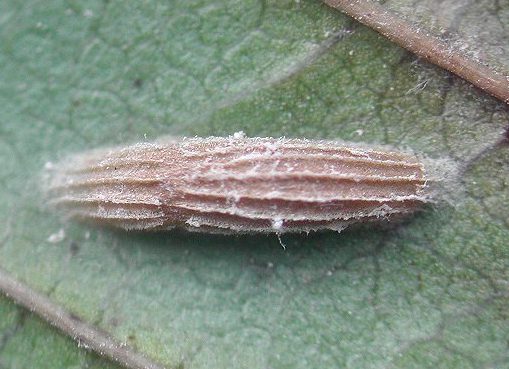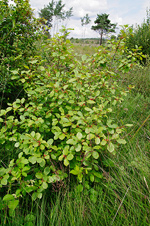|
||||||
|
FRANGULA. Alder Buckthorn. [Rhamnaceae] |
|
|
Alder Buckthorn (F. alnus) is the only species of Frangula recorded in Britain. Four Britiish miners are recorded on Frangula. A key to the European miners recorded on Rhamnus including Frangula is provided in Bladmineerders van Europa. |
|
|
Key for the identification of the known mines of British |
1a > Leaf-miner and case-bearer: The larva lives outside the mine, protected by a case, and feeds on the underlying plant tissues via a hole cut in the epidermis. From that point it eats away as much leaf tissue as it can reach without fully entering the mine. Mine does not contain frass (Coleophora species) |
1b > Leaf-miner, but not a case-bearer: The larva lives mainly inside the mine. Mine usually contains frass. In later instars the larva may live sandwiched between two more or less circular sections cut from the leaf. |
2 > Leaf-miner and case-bearer: Lobe case. The full grown case is about 7 mm long. The mouth angle is 0°, causing the case to lie flat on the leaf. The case is gradually enlarged by the addition of rings that are cut out of the epidermis. The rings become gradually larger, and stick irregularly out of the contour of the case. The rings are cut out of the lower epidermis of the mine. This implies that mines may have both normal, small openings, and large ones. Compare for instance C. violacea, that cuts rings out of the upper epidermis. The larva feeds briefly initially and again after over wintering. It then aestivates until Autumn. It makes one case which it enlarges by adding pieces of excised lower epidermis. |
|
Coleophora ahenella Heinemann, 1877 [Lepidoptera: Coleophoridae]. |
3a > Leaf-miner: The highly distinctive, violet or purplish spiral mines of this species are often the key to its discovery. They can be found on leaves, often several to a leaf. After the initial leaf-mining phase, the larva feeds externally on the underside of the leaves, creating small feeding windows, before pupating in a ribbed cocoon typical of the Bucculatriginae. A narrow corridor, densely wound, amost entirely filled with purplish brown frass. The last 1 to 2 cm of the corridor are free from the spiral, and almost straight. At this point the mine is left and the larvae continue to live free on the leaf, causing window feeding. The empty larval chamber, obviously free from frass, is conspicuousy slender. The egg, in the very centre of the spiral, is at the leaf lower side, as is the exit from the mine. |
 Bucculatrix frangutella cocoon Image: Rob Edmunds (British Leafminers) |
|
Bucculatrix frangutella (Goeze, 1783) [Lepidoptera: Bucculatricidae]. |
3b > Leaf-miner: The gallery is contorted in a series of S turns. The frass is initailly cloudy but then darker green being either dispersed or coiled (as shown). A little area of uneaten leaf is between each traverse. Finally the frass turns black and is deposited in a central line. The larva is greenish yellow, head pale brown. Full depth corridor, beginning at an under-surface egg shell. The corridor makes several sharp turns, causing the loops to (mostly) almost touch each other. In the last section the corridor is appreciably wider. Frass olive green when fresh, brown later, coiled for most of the length of the corridor. Pupation outside the mine. |
|
Stigmella catharticella (Stainton, 1853) [Lepidoptera: Nepticulidae]. |
3c > Leaf-miner: Full depth blotch, invariably beginning at the leaf tip or the tip of a leaf lobe or tooth. Oviposition site covered by a black, shining drop of hardened secretion. Frass generally in long threads, but sometimes in elongated granules. Pupation in the mine, not in a cocoon. |
|
Trachys minutus (Linnaeus, 1758) [Coleoptera: Buprestidae]. |
| Last updated 05-Jul-2019 Brian Pitkin | ||

